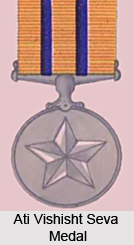 Ati Vishisht Seva Medal which is also known as AVSM awards is the non gallantry award which is mainly granted for distinguished services of exceptional order which has been specifically restricted to the non operational services as the Yudh Seva medals were created to recognise the exceptional services in the operational environment. Initially this medal was introduced in 26 January 1960 in the name of Vishisht medal Class II which was later on renamed as Ati Vishisht Seva Medal on January 27, 1967.
Ati Vishisht Seva Medal which is also known as AVSM awards is the non gallantry award which is mainly granted for distinguished services of exceptional order which has been specifically restricted to the non operational services as the Yudh Seva medals were created to recognise the exceptional services in the operational environment. Initially this medal was introduced in 26 January 1960 in the name of Vishisht medal Class II which was later on renamed as Ati Vishisht Seva Medal on January 27, 1967.
Ati Vishisht Seva Medal in its appearance is made up of 35mm circular silver medal with a five pointed star in the centre of the dial; suspended from a straight bar suspender, it carries the writings of `Ati Vishisht Seva Medal` in Hindi on the reverse side. The medal is suspended with ribbon which is orange in colour with two 2mm strips running from the centre.
Ati Vishisht Seva Medal like other medals includes officers from all ranks of Indian Armed forces which include Indian Army, Indian Navy and Indian Air force, Territorial armed units, Auxiliary and Reserved armed forces, the nursing services and the members of all the lawfully constituted armed forces. It too bears the condition that if the recipient of this award is granted this award a second time then it shall add a new bar to the riband by which the medal is suspended.
Thus remarkably this award is granted as non gallantry award which is awarded for non operational services at the time of peace.
This article is a stub. You can enrich by adding more information to it. Send your Write Up to content@indianetzone.com




















